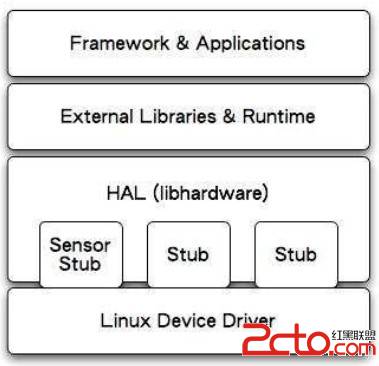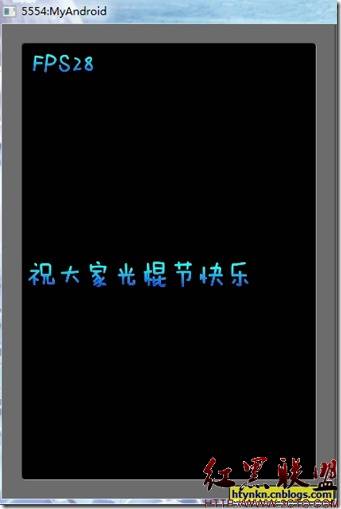Android HAL技术详解
本人喜欢用代码+伪代码的方式写笔记。文中的花括号可能是方便记录而已。
如:
hw_get_module(LED_HARDWARE_MODULE_ID, (const hw_module_t**)&module)
{
问:怎么获得模块信息的?
答:hardware\libhardware\Hardware.c
...........
}
第一部分:HAL层
hardware\led\include\Led.h
定义常见数据结构
struct led_module_t {
struct hw_module_t common;
};
struct led_control_device_t {
struct hw_device_t common; /*表示硬件设备*/
/* 属性 */
int fd;
/* 提供出来的方法 */
int (*set_on)(struct led_control_device_t *dev, int32_t led);
int (*set_off)(struct led_control_device_t *dev, int32_t led);
};
nstruct led_control_context_t {
struct led_control_device_t device;
};
hardware\led\led\Led.cpp 分析
static int led_device_open(const struct hw_module_t* module, const char* name,
struct hw_device_t** device)
{
struct led_control_device_t *dev;
/* 分配设备 */
dev = (struct led_control_device_t *)malloc(sizeof(*dev));
memset(dev, 0, sizeof(*dev));
dev->common.tag = HARDWARE_DEVICE_TAG;
dev->common.version = 0;
dev->common.module = (struct hw_module_t*)module; /*设置是属于哪个模块 */
dev->common.close = led_device_close;
dev->set_on = led_on{
/*自定义方法*/
int led_off(struct led_control_device_t *dev, int32_t led)
{
ioctl(g_fd, 0, led); //led on
}
}
dev->set_off = led_off; /*自定义方法*/
*device = &dev->common;
/*
/dev/leds0 内核驱动的device_create创建的
假如打开设备时候发生:Hello Stub: failed to open /dev/leds0 -- Permission denied.
进入到system/core/rootdir目录,里面有一个名为ueventd.rc文件,往里面添加一行:
/dev/hello 0666 root leds0
*/
g_fd = open("/dev/leds0", 0);
return 0;
}
/*模块方法表*/
static struct hw_module_methods_t led_module_methods = {
open: led_device_open
};
/*
模块信息
实例变量名必须为HAL_MODULE_INFO_SYM,
tag也必须为HARDWARE_MODULE_TAG,这是Android硬件抽象层规范规定的。
*/
extern "C" ① const struct led_module_t HAL_MODULE_INFO_SYM = {
common: {
tag: HARDWARE_MODULE_TAG,
version_major: 1,
version_minor: 0,
id: LED_HARDWARE_MODULE_ID,
name: "Sample LED Stub",
author: "The Forlinx Open Source Project",
methods: &led_module_methods, /*设置方法 */
}
/* supporting APIs go here */
};
① extern "C" :C++编写的代码片段可能被使用在其它语言编写的代码中。不同语言编写的代码互相调用是困难的。
为了使它们遵守统一规则,可以使用extern指定一个编译和连接规约。extern "C"指令中的C,表示的一种编译和连接规约,
而不是一种语言。C表示符合C语言的编译和连接规约的任何语言。
第二层: JNI 层次编写
frameworks\base\services\forlinx_led_jni\LedService.cpp
struct led_control_device_t *sLedDevice = NULL;//硬件设备的公告属性和方法
//方法描述
gMethods[] = {
{ "_init","()Z",(void *)forlinx_init {
jboolean forlinx_init(JNIEnv *env, jclass clazz)
{
led_module_t* module;
hw_get_module(LED_HARDWARE_MODULE_ID, (const hw_module_t**)&module)
{
问:怎么获得模块信息的?
答:hardware\libhardware\Hardware.c
hw_get_module(const char *id, const struct hw_module_t **module)
{
char prop[PATH_MAX];
char path[PATH_MAX];
for (i=0 ; i<HAL_VARIANT_KEYS_COUNT+1 ; i++)
{
property_get(variant_keys[i], prop, NULL)
{
问: variant_keys的数据是什么?
答: static const char *variant_keys[] = {
"ro.hardware",
"ro.product.board",
"ro.board.platform",
"ro.arch"
};
&nbs
补充:移动开发 , Android ,




